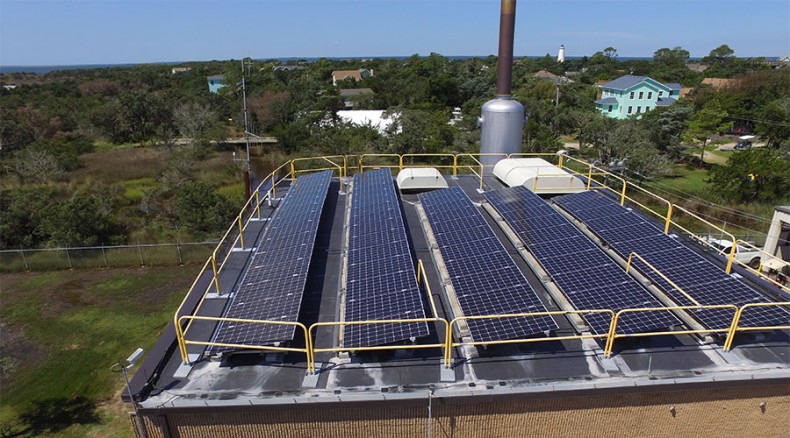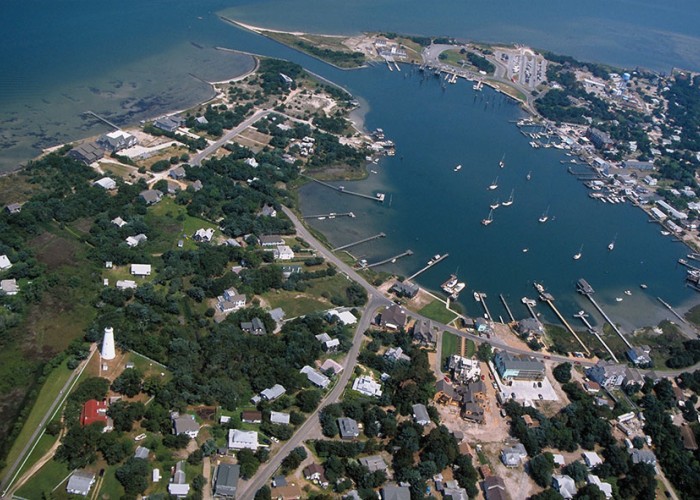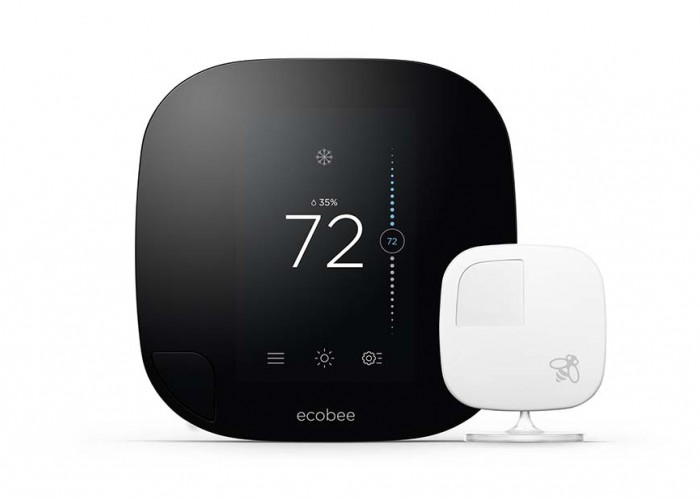Co-op Tech: The Agile, Fractal Grid
The Ocracoke microgrid project is paving the way for future innovation
By John VanvigThe microgrid's 62 solar panels are capable of adding roughly 15 kW to the island’s power supply. Photo courtesy of Tideland EMC
Fewer than a thousand people live on Ocracoke Island, a narrow spit of land in North Carolina’s Outer Banks, facing the Atlantic Ocean’s breakers at the end of a three-hour ferry ride from the mainland. Some tallies put the number of year-round residents at fewer than 600 hardy souls.
Whatever the actual number, they’re all co-op members, served by Pantego-based Tideland EMC and its power supplier, the North Carolina Electric Membership Corporation (NCEMC). They all live and work at the end of a transmission line that snakes along Hatteras Island to the north before plunging under the sea for 2 miles to tie Ocracoke’s homes and businesses to the rest of North America. And they, and the thousands of seasonal visitors who fuel the island’s economy, are all vulnerable to the threat of strong winds and turbulent seas from hurricanes and winter storms.
It would be hard to find a better place to design, build, and test a microgrid that can stand on its own when central-station power from the grid isn’t available. For almost a year, since February 2017, that’s what NCEMC and Tideland have been doing.
Years ago, the two co-ops put in a 3-MW diesel generator to provide emergency power for the island, and the community’s water and sewer system has backup power too. More recently, a few stores, shops, cafes, and homes have purchased small generators of their own to power their way through long interruptions.
Now, the Ocracoke microgrid project has seen the installation of 62 solar panels, which are capable of adding 15 kW to the island’s supply. There’s a new Tesla battery bank too, which can put an additional 500 kW into the island’s grid for a couple of hours.
On the member side, controlled home thermostats and water heaters can shave the need for electricity without sacrificing comfort. They’re deployed as needed during normal conditions and help conserve and extend power supplies during outages.
“It’s a test project so that we can monitor the operations,” says Lee Ragsdale, NCEMC’s senior vice president of grid infrastructure & compliance. “We are operating the Ocracoke microgrid to test some of these devices and procedures to see how they work together and share what we’ve learned with co-ops throughout the country.”
What they’ll learn and share will bring co-ops and the electric utility industry as a whole closer to the “agile, fractal grid,” a concept proposed by Craig Miller, chief scientist at the National Rural Electric Cooperative Association (NRECA), the service arm of the nation’s 900‑plus electric cooperatives.
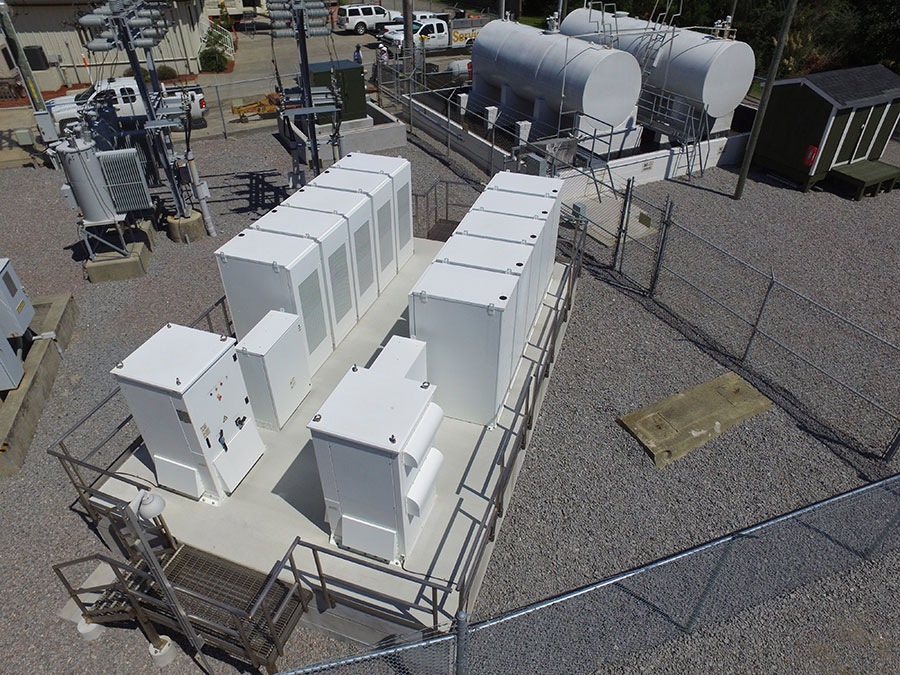
A 1 MWh Tesla battery bank can provide 500 kW of power in an hour when needed. Photo courtesy of Tideland EMC
The grid evolves
When it comes to the grid, “agile” means precisely that: nimble and fast in assessing and meeting the needs of electric consumers on a substation circuit or larger area affected by weather- or equipment-related service interruptions.
“Fractal” is a little less familiar term, but it’s an equally important aspect of microgrids. It describes formations or assemblies that break down into subunits with all the same characteristics of the larger whole.
As explained in the 2014 report “Achieving a Resilient and Agile Microgrid,” which Miller co-wrote with NRECA’s David Pinney and two others, a large salt crystal is fractal. When smashed, it crumbles into smaller salt crystals, all of them identical except in size to the original. When immersed in water, the crystals aggregate back into a large one.
A fractal microgrid, then, would include generation to supply power within its boundaries, controls to dispatch that power to where it’s needed (and shave demand where it’s not), and the ability to re-integrate itself into the larger grid when time and repairs allow.
“The agile grid is designed around segmentation,” the 2014 report explains. “Rather than building the grid as a monolith or hierarchy that operates as a unit, it is viewed as a collection of independent or semi-independent systems operating in a coordinated way.”
In the three years since publishing the report, Miller says the industry has moved even closer to the model of agile, fractal microgrids.
Distributed generation through solar arrays, wind turbines, backup generators, gas-fired peaking plants, and other technologies has boomed. Energy storage, via larger water heaters, electric vehicles that recharge overnight, and home battery banks, is gaining traction too.
A good bit of work remains to be done on communication and control mechanisms, Miller concedes. Secure and reliable internet and other communications links must be established, and interoperability standards for controlling distributed energy resources, load controls, and power-flow switches still are in the early stages. But those developments, Miller says, are well under way.
“It’s happening at dozens of utilities,” he says. “The grid doesn’t change overnight. It’s big, it’s complex, and we are responsible for developing it with integrity. So we make little changes, and the grid evolves.”
That evolution is on display on Ocracoke.
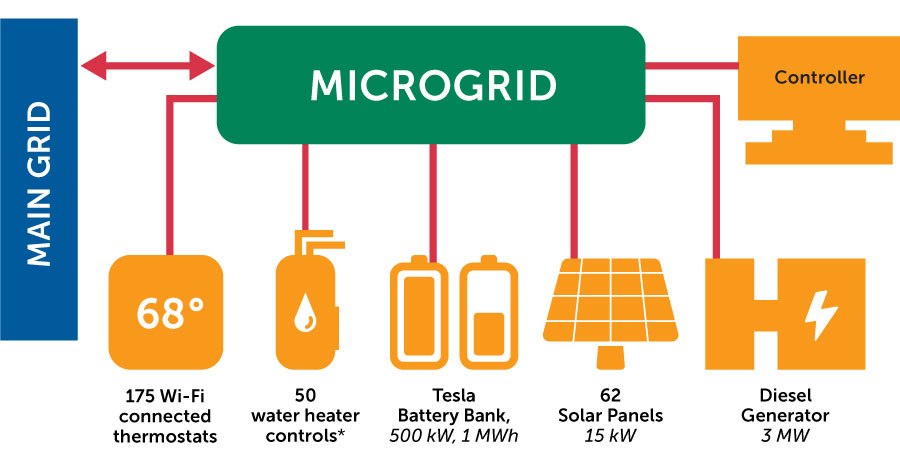
The Ocracoke Island microgrid is a component of the main electric grid, although it can work independently. The controller is the lynchpin of the microgrid, calling on demand response components, as well as controlling the generation and storage resources to balance load with available resources.
When engineers get excited
The 3-MW diesel generator, installed well before the microgrid project, functions as a kind of baseload power source when transmission access from the mainland is down. It’s supplemented by 15 kW of solar power and the battery bank.
Consumer-owned backup generation could eventually be incorporated into microgrid operation, Ragsdale says, though that will take further technical and business tweaks.
As Miller foretold, interoperability remains a challenge as the Ocracoke project matures.
“We spend as much time thinking about the communications between these devices as we do the flow of power,” Ragsdale says.
There’s a lot of communication links to think about. Data has to flow between generation and storage, between loads and the microgrid, and between all of that and control centers at Tideland and NCEMC.
“There is no off-the-shelf software you can buy and make it work,” says Ajaz Sadiq, NCEMC’s vice president of grid modernization & technology integration. “You need more interfaces to get it accomplished, and it requires constant adjustment to make it work the way we want.”
NCEMC can start the large diesel generator by remote control when needed, and staffers at Tideland’s outpost are on standby to help out, Sadiq says.
Microgrid communication relies on the existing business and telemetry networks on site, he says. But a lot of custom-built work came after that.
“We had to program a remote unit to interface between NCEMC and the individual device controllers. There is a human/machine interface computer that is programmed to interface with SCADA for local monitoring. Additionally, we had to develop custom interfaces to control the microgrid through our energy management system located in Raleigh.”
In the end, Sadiq believes the investment in systems design and development will pay off. “The time and effort was appropriate for a project of this scale,” he says.
Ragsdale makes the same cost-benefit calculation.
“That’s what we’re focusing on: figuring out that interoperability and how we control these devices,” he says. “One of the things that we’ve seen is that there’s a lot of stability associated with the mass of the larger grid. When you have a microgrid, you don’t have as much inertia on the system, so control becomes more complicated. That’s when the engineers get really excited.”
Baby steps
The Ocracoke Island microgrid project continues to evolve. The co-ops are testing how microgrid resources can provide benefits in normal conditions as well as when placed into service as an agile, fractal outlier.
“We have utilized these resources on multiple occasions,” Ragsdale says. “So now you have additional resources that you can utilize month in and month out.”
“Part of it is the reliability and resiliency aspect. Our [distribution co-op] members now have better reliability, and that adds value for their members. Ultimately, it’s about continuing to innovate to provide even better service to our members, and keeping power affordable and reliable. Both of those things are in place,” Ragsdale says. “We’re taking baby steps into it, and as we grow, it’ll make sense to do more. You crawl before you can walk before you can run.”
And that, NRECA’s Miller says, is the way the agile, fractal grid is appearing on the electric utility scene.
“We will never be able to say, ‘This is the day that we’re agile and fractal,’” he says. “We’ll just get there over time. Every day, somewhere in this country, one of our co-ops—because they’re very inventive people who work hard to deliver power—will try something. They’ll make a tweak somewhere, and then they’ll share those changes with each other. We are absolutely moving forward with the agile, fractal grid, today and every day.”
About the Author
This article originally appeared in the January 2018 issue of RE Magazine, produced by the National Rural Electric Cooperative Association.-
More Between the Lines
-
Share this story:

